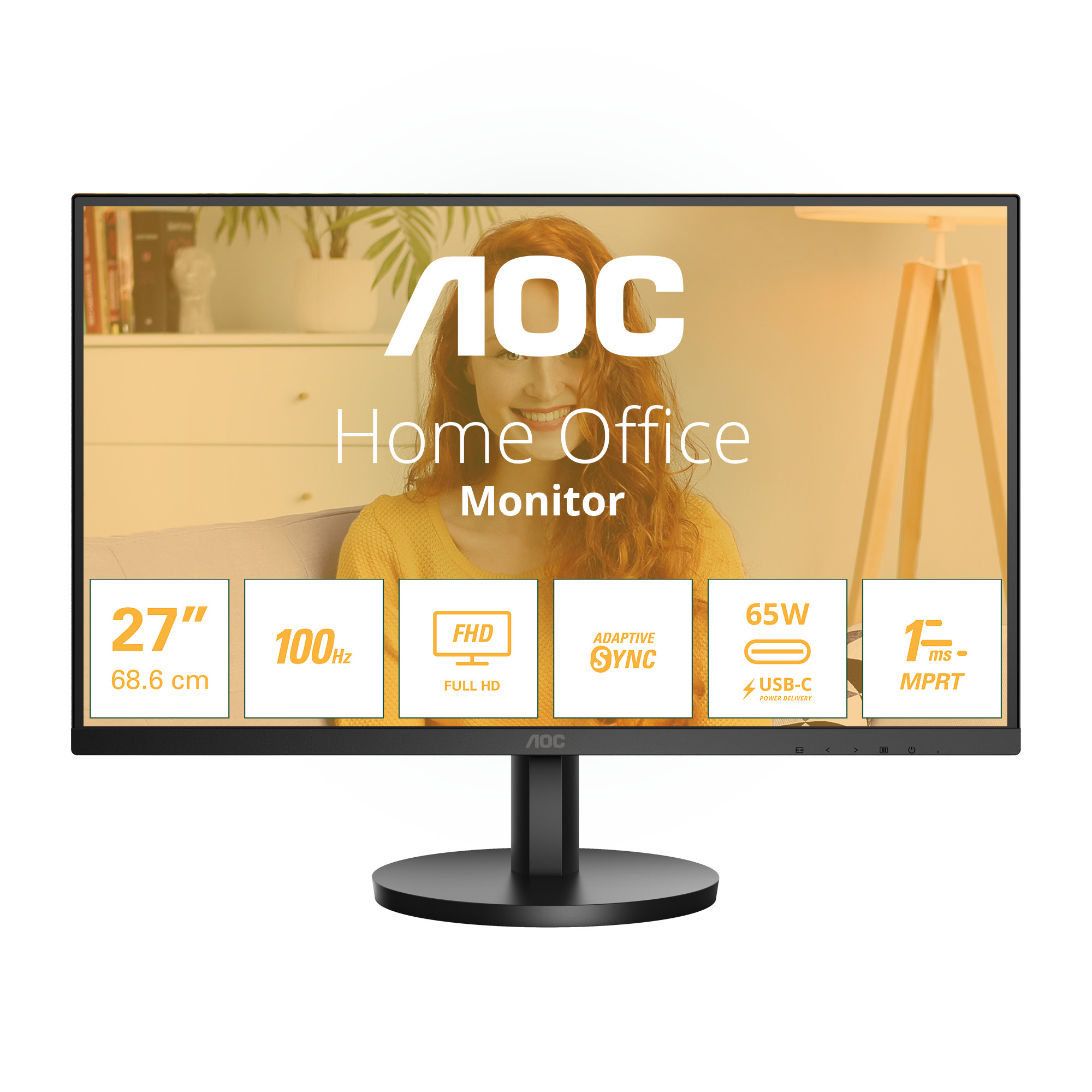



























£150.96*
£8.99
- Resolution 1920 x 1080 Full HD
- Diagonal 27"
- Panel type IPS
- Refresh Rate 100Hz



Product information
 With the AOC 27B3CA2 monitor, you get modern technology and a high level of user-friendliness in one device. The 27-inch display impresses with razor-sharp full HD resolution, a fluid refresh rate of 100 Hz and versatile connections – ideal for productive work, home office and demanding gaming. Thanks to the IPS panel and ultra-narrow bezel, you benefit from impressive image quality and a space-saving design.
With the AOC 27B3CA2 monitor, you get modern technology and a high level of user-friendliness in one device. The 27-inch display impresses with razor-sharp full HD resolution, a fluid refresh rate of 100 Hz and versatile connections – ideal for productive work, home office and demanding gaming. Thanks to the IPS panel and ultra-narrow bezel, you benefit from impressive image quality and a space-saving design.
The technical data at a glance:
- Screen size: 27 inches (68.6 cm)
- Resolution: 1920 × 1080 (Full HD)
- Panel type: IPS
- Refresh rate: 100 Hz
- Response time (MPRT): 1 ms
- Sync technology: Adaptive Sync
- USB-C: DisplayPort alternative mode, charging function
- Bezel type: Ultra narrow
- Built-in speakers: Yes
Fascinating image quality with Full HD and 100 Hz
Enjoy your favourite content in crystal-clear Full HD resolution. Whether you are watching a film, playing a game or using Office applications, the level of detail ensures an impressive viewing experience without placing heavy demands on your graphics hardware. With a refresh rate of 100 Hz, movements are displayed particularly smoothly. Jerk-free transitions and precise display help you to always keep an overview, even in fast-changing scenes.

Optimal connectivity with USB-C
Thanks to the USB-C connection, you can save yourself unnecessary cables and complicated setups. With just a single cable, you can transfer high-resolution video signals from your notebook to the monitor and charge your device at the same time. This gives you more space on your desk and minimises the need for cables and accessories.
Smooth gaming thanks to 1 ms MPRT and Adaptive Sync
The 27B3CA2 really comes into its own in action-packed scenes and fast-paced games. With just 1 ms MPRT, motion blur is significantly reduced – ideal for fast reactions. Adaptive Sync technology synchronises the refresh rate between the monitor and graphics processor, making annoying image errors such as tearing or judder a thing of the past. This is how you experience an outstandingly smooth gaming experience.

Built-in speakers and versatile connections
For your conferences, media playback and occasional gaming sessions, integrated speakers are available that do not require any additional external boxes. In addition to the practical USB-C port, the monitor also offers HDMI for modern consoles or streaming devices. This means you can quickly integrate the 27B3CA2 into your existing device environment.
Health-friendly technology and comfortable design
The Low Blue Light mode ensures that your visual comfort is maintained even during longer periods of screen time by reducing harmful blue light components. At the same time, the ultra-narrow bezel contributes to a pleasant, distraction-free look and allows the use of multiple monitors side by side if needed. With the AOC 27B3CA2, you combine modern design, ergonomics and state-of-the-art technology for an all-round convincing performance.
Technical data
| Name | AOC 27B3CA2 27" IPS Monitor, 1920 x 1080 Full HD, 100Hz, 1ms |
|---|---|
| Article number | 1000033179 |
| GTIN/EAN | 4038986181471 |
| Manufacturer SKU | 27B3CA2 |
| EPREL ID | 1838036 |
| Model name | 27B3CA2 |
| Brand | AOC |
| Product Type | Monitor |
| Technology | LCD |
| Panel type | IPS |
| backlight | LED |
| Resolution | 1920 x 1080 Full HD |
| Diagonal | 27" |
| Aspect Ratio | 16:9 |
| Viewing angle - Horizontal | 178° |
| Viewing angle - Vertical | 178° |
| Contrast Ratio | 1,300 :1 |
| Max. Brightness | 250 cd/m² |
| Response time | 1ms |
| Refresh Rate | 100Hz |
| Support - VESA | 100 x 100 |
| Inputs | 1x HDMI , 1x USB-C |
| Outputs | 1x 3,5mm Jack |
| Features | Integrated speaker |
| Product width | 61.66 cm |
| Product height | 35.67 cm |
| Product depth | 4.54 cm |
| Weight | 4.05 kg |
| Colour | Black |
| EEK Spectrum | A to G |
| Energy efficency class | E |
| Condition | New |
| Warranty | 36 Month |
| Warranty type | Bringin service Service and support information |
Product safety
| Person responsible for the EU |
|---|
| AOC International (Europe) B.V. |
| Amstelgebouw Prinsbernardplein 200 / 6th floor |
| 1097 JB Amsterdam |
| Netherlands |
| info@tpv-tech.com |



